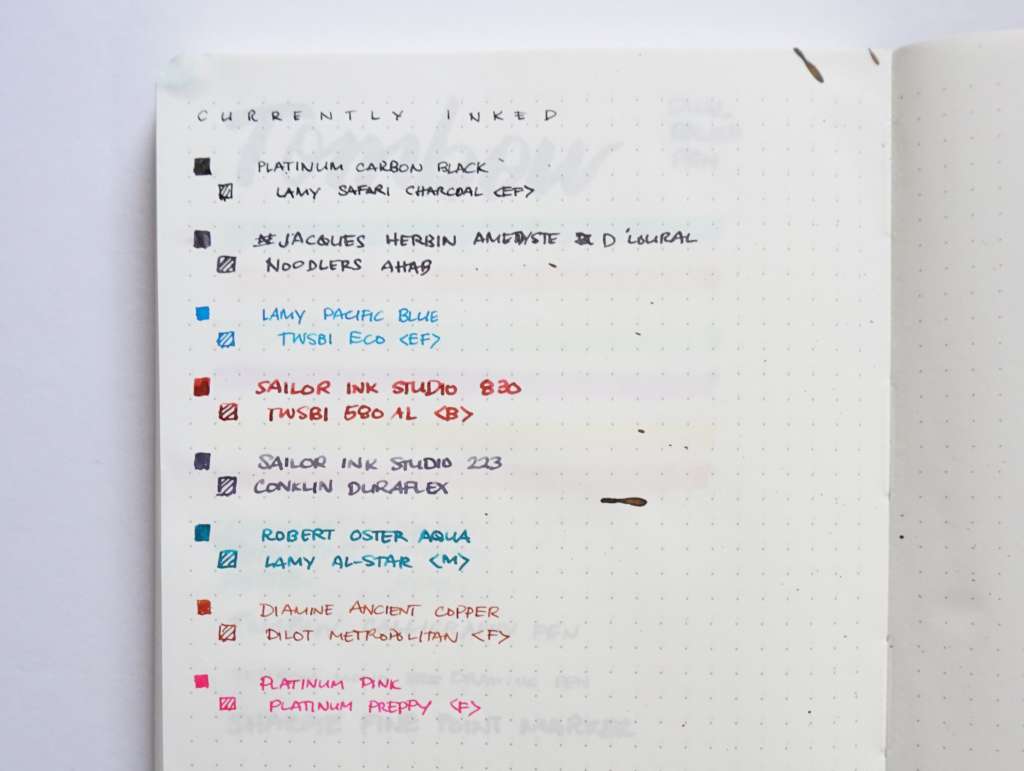Tomoe River is one of the best fountain pen friendly paper, in my opinion. Because for such a thin paper (at 52 gsm), it handles fountain pen ink really well. You can dump a lot of ink on the paper and you won’t see it bleed-through the rest of the pages (see image below).
There are other properties that make this paper special and highly coveted by fountain pen lovers such as:

Back of page
I don’t have any complaints with the Tomoe River paper. I can’t get enough of it and if I could write all day with it, I would. Tomoe River paper is great but it’s not perfect. There are still a few drawbacks that could possible turn others off the Tomoe River and that’s what we’re going to focus on in this article.
Ghosting
Tomoe River paper has been likened to to tracing paper because of its translucency. Ghosting is to be expected from such a thin paper – at 52gsm and 68gsm. The ink showing through the other side of the page isn’t as bad as one might think but this is definitely something to note.

I don’t think it’s noticeable unless you *really* look at it. I’ve taken writing samples from my Tomoe River journal. The only time that the ghosting will be go unnoticed is when you’ve used a dark colored ink on one side and a light colored in on the other. Or perhaps if you have used a fountain pen that dumps a lot of ink (like a stub, flex, or broad nib).
Slow drying times
This paper is crazy smooth that it takes a while for the paper to absorb all that ink. I hadn’t noticed it until I started to use inks that took too long to dry, like the infamous Noodler’s Apache Sunset.
Lefties, beware. I have heard that some left-handed fountain pen users aren’t huge fans of the Tomoe River paper because of the slow dry time. If you’re a lefty but still want to use Tomoe River, maybe consider investing on quicker drying inks.
If you’re a left-handed fountain pen geek, please feel free to share your insights in the comments.
A Bit Expensive
Superior quality paper will inevitably come at an expense.
I still wanted to highlight this as a drawback because price could be a dealbreaker for some.
So for argument’s sake, we will compare a Tomoe River notebook with a Rhodia notebook and use prices from Goulet Pens.
| Rhodia Classic Side Staplebound Notebook | Goulet Notebook w/ 52gsm Tomoe River Paper | |
|---|---|---|
| Size | A5 | A5 |
| Price | $3.75 | $9.00 |
| # of Pages | 96 | 96 |
| Price per page | $0.039 | $0.09 |
Using this alone, we can clearly see the price difference between two of the best fountain pen friendly papers. Tomoe River notebooks, even when simply bound by staples and covered with merely card stock, are still more expensive than the Rhodia notebook.
Tomoe River notebooks aren’t easy to come across
Notebooks that use Tomoe River paper aren’t abundant. You can’t just find one at a stationery store as easily as the Leuchtturm or Rhodia. In the past, there have only been a few that sold Tomoe River notebooks like Nanami, Taroko Design, and Hobonichi (a planner that uses Tomoe River paper).
You’d probably find a few on Amazon but they might not be available in your country (you’d have to pay extra for shipping).
Fortunately, now, there are a few small businesses (mostly fountain pen lovers) that create their own line of notebooks that use Tomoe River paper.
Still great paper, nonetheless
These 4 things might be a few reasons that would make some opt notebooks such as the Rhodia and Clairefontaine. However, the Tomoe River paper’s best quality would be its ability to handle fountain pen ink, regardless of amount and also its ability to bring out the best characteristics of the ink.
If you are still on the fence about Tomoe River paper because of how thin it is but love how it shows off sheen, you can try the Midori’s notebooks, among other alternatives.
- Read: Midori MD Light Review

Amazon Disclosure
Rediscover Analog is a participant in the Amazon Services LLC Associates Program, an affiliate advertising program designed to provide a means for sites to earn advertising fees by advertising and linking to Amazon.com











